Oct 18, 2017 | cents, coins, currency, dollar, Federal Reserve, US Mint
Could the recent cyber attacks and growing severity of cybersecurity issues become the motivation for Congress to vote to reform United States currency?
According to Philip Diehl and Edmund Moy, former Directors of the U.S. Mint, the discussion as to remove the cent and paper dollar from circulation should be part of the current budget and tax overhaul debates.
-
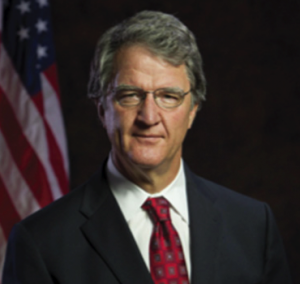
-
Philip N. Diehl
35th Director of the U.S. Mint
June 1994 — March 2000
-

-
Edmund C. Moy
38th Director of the U.S. Mint
September 2006 — January 2011
The discussion is the same as it has been. The cost of zinc has risen causing the manufacturing costs of the Lincoln cent to climb above its face value. Even with operating efficiencies that have brought down the cost of manufacturing to its lowest levels in many years, the price of zinc keeps makes the materials cost more than the coin is worth.
As for the paper dollar, the Government Accountability Office has published several reports over the years that demonstrate the cost savings between using the paper dollar versus a coin dollar. The last GAO report (GAO-13-164T) concluded that using a dollar coin instead of the paper note “could potentially provide $4.4 billion in net benefits to the federal government over 30 years.”
This is not a new discussion. The only change is that this is being suggested by former Directors of the U.S. Mint from both sides of the aisle. Diehl was appointed by Bill Clinton and served from June 1994 through March 2000. Moy was appointed by George W. Bush and served from September 2006 through January 2011.
Earlier this year, Sen. John McCain (R-AZ) introduced the Currency Optimization, Innovation, and National Savings Act of 2017 (COINS Act) (S. 759). McCain’s bill would require:
- Suspending the production of the one-cent coin for 10 years except for collectibles. After three years, the GAO would doe a study to determine whether production should remain suspended or should be reinstated. This would not demonetize the cent.
- Change the composition of the nickel to 80-percent copper and 20-percent nickel. This should bring down the cost of materials used in striking the five-cent coin to be on par with its value. Efficiencies in manufacturing could lower costs further.
- If the bill becomes law, two years after it is enacted, the Federal Reserve will begin removing $1 Federal Reserve Notes from circulation. This will probably be done by the banks who will take the notes on deposit and send them back to the Federal Reserve where they will be destroyed. Coins would take their place. The $1 FRN could still be produced for the collector market.
Sources report that the chances of McCain’s bill getting a hearing are minuscule. While having lunch with on congressional staffer, I was given three reasons why Congress will not address this issue:
- States with a large rural population primarily west of the Mississippi River represented by Republicans are unlikely to support the removal of the one-cent coin. Removal of the coin is viewed as a hidden tax against the people with fear mongering that suggest the government is keeping the extra money that would become on the rounding of prices.
- States with large poor populations, primarily in the south, and their advocates who believe that taking away the pennies are a way to separate more money from poor people who can least afford to lose the ability to pay in cents.
- Surveys show that most of the people older than Millenials are against removing the paper dollar. Since this population constitutes the majority of the voters and donors, the politicians are not about to make those people upset.
Another issue is that McCain is not popular amongst his fellow Republicans. If the issue is addressed, it is likely to be discussed as part of a bill that does not bear McCain’s sponsorship.
Given the partisan nature of politics and the perceptions of the members of Congress, there is a very little chance of the Coins Act or any similar legislation being enacted during this session of Congress.
Oct 15, 2017 | Britain, coins, foreign
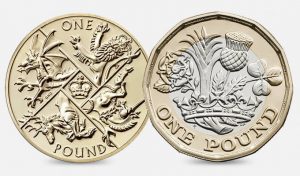
The old Round Pound and the new 12-sided £1 coin
British news outlets are reporting that millions of the old round pounds are still in circulation but that might not be bad news for many Britons. There are reports that many coin-operated systems have not been converted to take the new 12-sided £1 coin including supermarkets, where a £1 pound coin is necessary to “rent” a trolley, what the British call their shopping cart.
Two of the U.K.’s largest grocery store chains have announced they will continue to accept the round pound through the end of October because their trolley systems are not ready.
Charities are getting into the act by accepting the old round pound as donations. Many charities will continue to accept the coin through the final redemption period in March 2018 as donations. The charities are working with banks to deposit the coins.
It has been fascinating to read the news of how the U.K. has tried to adapt to the new coin. The biggest issue has been with the use of coin-operated equipment like trolley rentals and parking meters. It is a lesson to any active economy, such as her in the United States, as to what could happen should the composition of U.S. coins change.
Although there have been discussions as to whether to change the composition of United States coinage, it is not likely to happen for many reasons. What may be gaining support is dropping the $1 Federal Reserve Note in favor of a dollar coin. This would not require changes in coin-operated systems but a change in attitudes. Given how resilient Americans can be, it would be possible to end production of the $1 FRN and just endure the kvetching that will ensue. That will end when people get used the coin.
And now the news…
October 9, 2017
LeRoy Transfield A photo of the New Zealand Expeditionary Force, Native Contingent. Utah sculptor LeRoy Transfield had two uncles who served in the unit during World War I. → Read more at deseretnews.com
October 11, 2017
The discovery of gold rings and coins on a Swedish island sheds new light on the history of the area, and could give insight into the motives for a massacre which took place in the fifth century, archaeologists told The Local on Wednesday. → Read more at thelocal.se
October 12, 2017
Share → Read more at adweek.com
October 12, 2017
People buy gold in various forms like jewellery, coins etc. Here are 7 things to know if you are buying gold coins this Diwali. → Read more at economictimes.indiatimes.com
October 13, 2017
The Carl Brashear Foundation wants to bring its namesake’s legacy home to the veterans center that soon will bear his name. → Read more at thenewsenterprise.com
October 14, 2017
By Katie Lange Defense Media Activity → Read more at dodlive.mil
October 15, 2017
Shoppers have one day left to spend their old round £1 coins before they cease to become legal tender at midnight. Hundreds of millions of round pounds are yet to be handed in, as only hours remain before the coin drops out of general circulation. However, major banks and building societies have said they will continue to accept the old coins after the deadline on Sunday. They can also be deposited into any of the usual high street banks or through the Post Office. → Read more at independent.co.uk
October 15, 2017
Sunday, October 15, 2017 → Read more at jamaicaobserver.com
October 15, 2017
Currency modernization will help secure our financial futures and save billions of dollars for taxpayers. → Read more at cnbc.com
Oct 13, 2017 | coins, commemorative, news
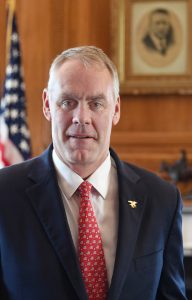
Secretary of the Interior Ryan K. Zinke
In an article that appeared in The Washington Post, it was reported that Secretary of the Interior Ryan Zinke has the department fly a special flag on top of the agency’s building in Washington, D.C. when he is in the office. On days Zinke is not in the office, a flag is raised for Deputy Secretary David Bernhardt.
Zinke, the former Montana congressman, is a former Navy SEAL commander and may have adopted this tradition from his time in the service.
Zinke also commissioned personalized challenge coins to give to staff and visitors.
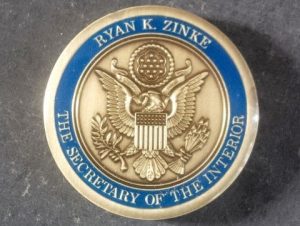
Challenge Coin commissioned by Interior Secretary Ryan Zinke
Typically, a challenge coin is a small medal, usually no larger than 2-inches in diameter, with the insignia or emblem of the organization. Two-sided challenge coins may have the emblem of the service on the front and the back has the emblem of the division or other representative services. Challenge coins are traditionally given by a commander in recognition of special achievement or can be exchanged as recognition for visiting an organization.
Receiving a challenge coin, especially from a high ranking official is supposed to be considered an honor.
Over the last 15 years, challenge coins became popular outside of the military as retired service members began to work in other areas of the government. The tradition has even been adopted by state and local governments and sometimes used to help raise money for municipal projects.
While most agencies have challenge coins, Zinke may be the only secretary to have one personalized. There was no report on the cost of the coins to taxpayers.
Although having a personalized challenge coin along with his flag ritual is unusual for a Cabinet-level official, there appears nothing wrong with him doing this. Zinke appears to have enthusiastically embraced his job at the Department of the Interior and if he uses the challenge coin to help reward department employees, then this is a good move on his part.
Credits
- Official portrait of Secretary Zinke courtesy of the Department of the Interior.
- Zinke Challenge Coin image courtesy of The Washington Post.
Oct 12, 2017 | Britain, coins, counterfeit, errors, foreign
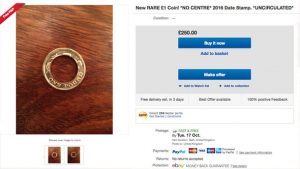 As the British are winding down the use of the Round Pound, stories are once again popping up about errors of the new 12-sided pound coin being sold for high prices on eBay.
As the British are winding down the use of the Round Pound, stories are once again popping up about errors of the new 12-sided pound coin being sold for high prices on eBay.
Although the Royal Mint has admitted to manufacturing issues in trying to produce enough new pound coins to satisfy circulation requirements, their claim that the number of errors where the center are missing of the bi-metallic coins is likely post-minting errors.
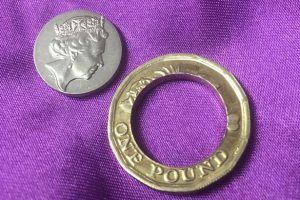
A weak strike can prevent the two metals from fusing properly allowing them to separate
To better understand why it is being claimed these are post-mint errors, I contacted a European-based dealer who has relationships with many of the continent’s mints. What follows is a summary of his explanation.
The Royal Mint coins money in a process similar to any other mint. Planchets are prepared, sent the coining press, stamped, dumped into a hopper, and sent down a conveyor where they are bagged. The bags are weight to a precise weight before the bags are accepted. Along the way, there are cameras and other sensors to detect errors.
All of the checks and sensors, including the weight of the coin, would be caught long before reaching the bagging section. Aside from the dimensions not being correct, the weight of the ring or center by themselves would not be up to the standard.
It is possible that the coins could separate in the bags during transport. However, these coins are transported to government authorized handlers. Some of them are similar to the companies that drive armored trucks here in the United States. They take the coins and prepare them for delivery to the banks.
The preparation process requires coins to be counted, rolled, and bagged. As part of the process, the coins are loaded into a system that transfers them to an automated line that brings the coins by conveyor to a machine that will either roll them or dump them in a bag. In both cases, the contents are limited by the amount they hold.
As part of the automated system, the coins are counted and check for size and weight so that if there are any coins that do not meet the Royal Mint’s standards are removed. The automated system would catch the ring and the center if they separated before the process.
Coins that are to be rolled are sent to a machine to roll them where they are counted and placed in rolls of £25 each. Those rolls are for bank and retail use and handled accordingly.
Bagged coins are used by bulk handlers such as the coin-op industry. Bags with £100 of coins are counted before being placed in the bag. If the coin cannot be verified before it is placed in the bag then the coin is rejected.
Is it possible for the coin to separate in the £100 pound bag prior to circulation? Of course, it is. However, there is one more check before the coins reach the consumer, and that is the coin-op machine itself.
Coin-op machines have mechanisms to try to prevent accepting counterfeit money and to ensure it is giving the proper change. Machines just do not eject any coin in its hopper. These checks include the weight, dimensions, and magnetic signature. The magnetic signature measures what happens after magnetic energy is flashed on the coin. Think about it as measuring how the coin would reflect light but use magnetism instead.
A pound coin that had separated would not pass the magnetic signature test and be rejected.
Although there are a number of points along the process that could fail, the number of checks between the Royal Mint and the consumer, it is highly unlikely that all of these separated pound coins exist.
It is possible that the coins being sold are from the reject bins of coin-op machines. However, the dealer I spoke with is suspicious of the number of coins being sold.
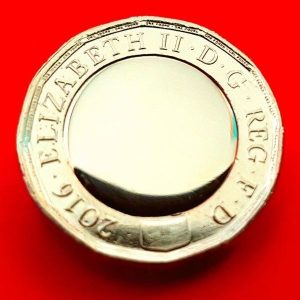
Trial strikes found without the effigy of Queen Elizabeth, II
My dealer contact said that nobody should pay more than “three-and-a-half quid” (£3.50 or $4.64 at the current exchange rate) for just a 12-sided pound outer ring. Even if it is not a legitimate Royal Mint error it is a nice conversation piece.
Examples of legitimate 12-sided £1 coin errors
-
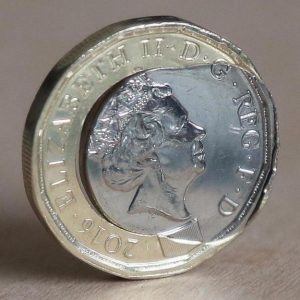
-
Too hard of a strike is likely to have caused the copper-nickel center to melt across the coin.
-
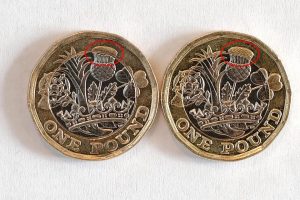
-
First new £1 coin error found with missing detail on the thistle
Oct 11, 2017 | celebration, coin design, coins, commemorative, US Mint

Utah sculptor LeRoy Transfield, right, poses in his sculpting studio in Orem.
The winning design was submitted by LeRoy Transfield, a sculptor from Orem, Utah.
In an interview that appeared in the Desert News, Transfield said that he had two uncles that served as members of the New Zealand Expeditionary Force Native Contingent during World War I. This lead to his interest in learning about the history of the war.
-
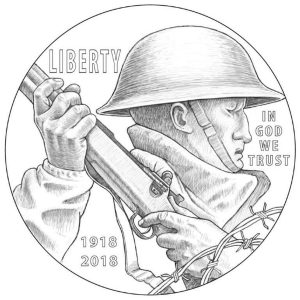
-
2018 World War I Centennial Silver Dollar Obverse — “Soldier’s Charge” by LeRoy Transfield
-
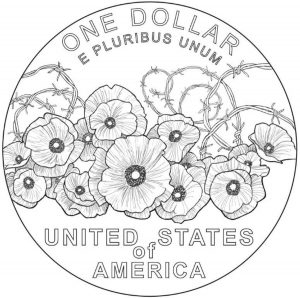
-
2018 World War I Centennial Silver Dollar Reverse — “Poppies in the Wire” by LeRoy Transfield
For the obverse, Transfield titled it “Soldier’s Charge.” In the interview, Transfield said that he “didn’t want him to look like some model in an artist’s studio. I made his nose like it might’ve been broken. I wanted to give him a rugged looking face. … I wanted that feeling of combat”
Transfield said that the reverse was more difficult to for him to design. After several tried he came up with the “Poppies in the Wire”
In 2012,
I wrote about the poem “In Flanders Fields” and suggested that it be adopted on a U.S. commemorative coin. It only took five years for my suggestion to become a reality! You can read about the poem and my recommendation
→ here.
Poppies are a fitting tribute since their use was inspired by the poem “In Flanders Fields.” The poem was written by Lt. Col. John McCrae, a Canadian physician following the funeral of a friend and fellow soldier who died in battle. It was published in 1915 and first adopted by the American Legion to commemorate the American Soldiers killed in the war. It was later adopted by veterans groups within the British Empire including Canada.
Transfield is originally from New Zealand but moved to the United States to attend BYU-Hawaii. After graduating with a Bachelors of Fine Arts degree, he moved with his wife to Orem where he operates a sculpting studio in his garage.
Based on the line drawing, it appears that this is going to be an excellent design when struck on a 40mm silver planchet. This is one time where it appears that the Citizens Coinage Advisory Committee and the U.S. Commission of Fine Arts got it right in picking the design.
The World War I American Veterans Centennial Commemorative Coin will be issued in 2018. According to the law (Public Law 113-212) , the U.S. Mint is limited to selling no more than 350,000 silver dollars. Each coin will have a $10 surcharge (a maximum of $3.5 million) will be paid to the U.S. Foundation for the Commemoration of the World Wars to assist the World War I Centennial Commission in commemorating the centenary of World War I.
Given the texture in the both the soldier on the front and the poppies on the reverse, it will be interesting to see if the U.S. Mint comes up with an enhanced uncirculated version. It could be extraordinary!
Credits
- Image of LeRoy Transfield in his studio courtesy of the Desert News.
- Coin line art images courtesy of the U.S. Mint.
Oct 8, 2017 | news, US Mint

David J. Ryder
Ryder’s biography in the President’s announcement was as follows:
David J. Ryder of New Jersey to be Director of the United States Mint. Mr. Ryder served as manager and managing director of currency for Honeywell Authentication Technologies. Previously, Mr. Ryder served as CEO of Secure Products Corporation, which was acquired by Honeywell in 2007. In 1991, Mr. Ryder was nominated by President George H.W. Bush and confirmed by the U.S. Senate to serve as Director of the U.S. Mint. His prior government service also included Deputy Treasurer of the United States, Assistant to the Vice President and Deputy Chief of Staff to Vice President Daniel Quayle. Mr. Ryder was born in Billings, Montana and raised in Boise, Idaho. A graduate of Boise State University, Mr. Ryder is married with two children.
The U.S. Mint has not had a permanent director since Edmund Moy resigned in January 2011. Since Moy’s departure there have been a series of Deputy Directors fulfilling the Director’s role including Rhett Jeppson, who was the last nomination not to be considered by the U.S. Senate. Although the Senate Committee on Banking, Housing and Urban Affairs did held a hearing on Jeppson’s nomination, they failed to bring the nomination to the floor for a vote.
If Ryder’s nomination is confirmed, he will be the 39th Director of the U.S. Mint and the only person to hold the job for two non-consecutive terms.
PN1082: David J. Ryder — Department of the Treasury
Date Received from President: October 5, 2017
Summary: David J. Ryder, of New Jersey, to be Director of the Mint for a term of five years, vice Edmund C. Moy, resigned.
Received in the Senate and referred to the Committee on Banking, Housing, and Urban Affairs. — Oct 5, 2017
Now for the news…
October 2, 2017
An amateur historian from Devon digging in a farmer's field has told how he found a once-in-a-lifetime hoard of 2000-year-old Roman silver coins – worth up to £200,000. Mike Smale, 35, found the hoard of 600 rare denarii in a farmer's field in Bridport while hunting with his pals from the Southern Detectorists club. → Read more at devonlive.com
October 2, 2017
The U.S. Mint is on track for the lowest sales of American Eagle coins in almost a decade. The 2008 financial crisis began a historic ramp up in sales that lasted for years. 20,583,000 silver American Eagles sold that year, more than double the 2007 total of 9,028,036 coins. → Read more at silverseek.com
October 5, 2017
The negative sentiment toward gold prevailed on Friday, September 29, the last trading day of the month. Gold futures for November expiration fell 0.3% and closed at $1,282.7 per ounce. The call implied volatility in gold was at 9.7%—the lowest level in September. (Call implied volatility is a measurement of the fluctuations in the price of an asset with respect to the changes in the price of its call option.) → Read more at marketrealist.com
October 6, 2017
Arizona Gov. Doug Ducey signed a law in May to exempt the sale of U.S. gold coins in the state from capital gains taxes.The measure said taxing a gold coin investment was unfair because the transaction was an exchange of one currency for another. Tax free status would arguably spur investment, but that does not seem to be happening on the large scale.Sales of gold coins in the first nine months of the year shrank to the lowest in a decade, according to new data from the U.S. Mint. Despite preferential tax status in Arizona, investors are choosing the stock market. → Read more at kjzz.org
October 7, 2017
The Sussex ambulance driver will face no further action after saying his children found the coins. → Read more at bbc.com
October 7, 2017
The Bangko Sentral ng Pilipinas yesterday said it would penalize people found willfully defacing, mutilating, tearing, burning or destroying currency notes and coins. → Read more at philstar.com
October 8, 2017
Penny-wise and coin foolish: Don’t eliminate 1 cent → Read more at orlandosentinel.com
Oct 7, 2017 | Britain, currency, foreign
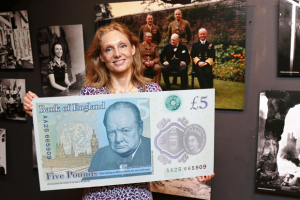
Victoria Cleland, Chief Cashier at the Bank of England, presenting the Churchill War Rooms with their New Fiver
Tallow is made from suet, the fatty deposits around the organs of cows and sheep. It is a byproduct of the process of butchering a cow for its meat and hides. In its natural form, suet is only used for cooking and some preservation. When it is rendered (by boiling) into tallow, it is used to manufacture soap, candles, and lubricants. The use of tallow in even the most synthetic lubricant is ubiquitous. Machines used to harvest crops or grease moving parts in automobiles have tallow in them.
Since the uproar from vegan activists, the Bank of England spent a lot of time and a lot of money to research the environmental and social impact of tallow in the notes.
The amount of paperwork that was generated for this issue is astounding. They looked at everything from the use of alternative lubricants, like palm oil, to the religious and social impacts to Her Majesty’s loyal subjects. In the final report, the Bank of England even summarized the response when they reached out to “representative groups,” both religious and activists organizations.
All that time and money led to the decision to “ not change the composition of the polymer used for future notes.” Why? Because the costs and environmental impact to using alternatives like palm oil would be more expensive, the notes have such low amounts of tallow, typically less than 0.05-percent (five-one-hundredths of a percent) of derived animal products, and the rest of the community just does not see this as a problem!
It is like I said in my original post, they are probably breathing more dander in a single day than they are touching tallow in all of the polymer banknotes that cross their paths. Tallow is used in all sorts of lubrication products, especially those used in transportation. It is everywhere.
I hope the vegans can either learn to live within society’s decisions or find another way to pay for goods and services, like using credit cards.
Oct 5, 2017 | cents, coins, copper, errors
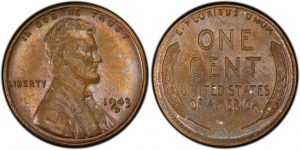
1943-D Bronze Lincoln Cent graded MS-64BN by PCGS
Raymond Reddington, played by James Spader, was trying to gain the attention of a high-rolling thief and found himself at a numismatic auction. The item up for bid was the 1943-D Bronze Lincoln cent. As part of the story, it was announced that it was the only one known to exist and that it was graded by the Professional Coin Grading Service.
Currently, there is only one known 1943-D Bronze Lincoln Cent and was graded by PCGS to be MS-64BN. It last sold for $1.7 million in 2010.
Since then, more 1943 Bronze Lincoln Cents were found including a 1943-S graded MS-62BN by PCGS. That coin was sold to Bill Simpson, a co-owner of the Texas Rangers, for $1 million in 2012. Simpson owns a complete set of 1943-PDS and 1944-PDS off-metal Lincoln cents, the latter made of zinc coated steel.
In the show, the hammer price was $3 million. All things considered, it is probably an accurate estimate of what the coin might be worth if it were to come to market today.
Of course, they did not use a real 1943-D Bronze Lincoln cent and there was a mistake when the coin showed up later in the story. But if you have not seen this episode, I am not going to spoil it for you!
Oct 3, 2017 | coins, commemorative, legislative
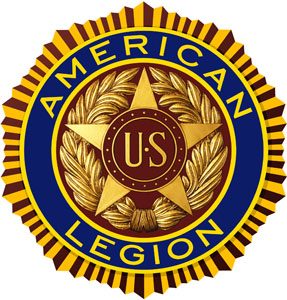 Sometimes, it takes time for the online system to catch up with the acts of Congress. But in what looks like a rare display of bipartisanship, the Senate passed The American Legion 100th Anniversary Commemorative Coin Act (H.R. 2519) on September 29, 2017. It becomes the first piece of numismatic-related legislation passed by the 115th Congress.
Sometimes, it takes time for the online system to catch up with the acts of Congress. But in what looks like a rare display of bipartisanship, the Senate passed The American Legion 100th Anniversary Commemorative Coin Act (H.R. 2519) on September 29, 2017. It becomes the first piece of numismatic-related legislation passed by the 115th Congress.
When signed by the president, who is in Puerto Rico today and expected to be in Las Vegas tomorrow, the American Legion 100th Anniversary Commemorative Coin program will be the second commemorative program of 2019. The other is the Apollo 11 50th Anniversary Commemorative program.
Typical of the three coin commemorative programs, the law authorizes a $5 gold, $1 silver, half-dollar clad coins with maximum mintages of 50,000, 400,000, and 750,000 respectively.
According to the bill, “The design for the coins minted under this Act shall be emblematic of The American Legion.” Other than the required inscriptions, no other restrictions were placed on the design except the required reviews by the U.S. Commission of Fine Arts and Citizens Coinage Advisory Committee.
Surcharges of $35 for the gold coin, $10 for the silver coin, and $5 for the clad coin will go to the American Legion to help with their service efforts. If the program sells out, the Amercian Legion can earn $9.5 million.
H.R. 2519: The American Legion 100th Anniversary Commemorative Coin Act
Summary: This bill requires the Department of the Treasury to mint and issue commemorative coins in recognition and celebration of the 100th anniversary of the American Legion.Surcharges received from the sale of these coins shall be paid to the American Legion for costs related to promoting the importance of: (1) caring for those who have served, and those who are still serving, in the Armed Forces; and (2) maintaining patriotic values, strong families, and assistance for at-risk children.
Referred to the House Committee on Financial Services. — May 18, 2017
Motion to reconsider laid on the table Agreed to without objection. — Sep 25, 2017
Received in the Senate. — Sep 26, 2017
Message on Senate action sent to the House. — Sep 29, 2017
Presented to President. — Sep 29, 2017
Oct 1, 2017 | markets, news, palladium
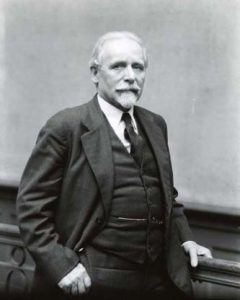
Adolph Alexander Weinman
(1870-1952)
Pre-sale prices are averaging $85-200 over the spot price, which is currently $928.00 on the world market. Since the U.S. Mint only sells coins to authorized dealers, those dealers will act as wholesalers down the chain. Each time a coin changes hands, there will be a markup. A coin can pass through a few hands before being offered for sale to the public.
And these prices are before the dealers rush to slab these coins. I am sure those grading MS-70 will go for significant premiums!
If you are interested in buying the coin, I would recommend shopping around. However, if you have a favorite dealer and there is not much of a difference between an online price and the dealer, you may want to consider supporting your local dealer!
And now the news…
September 25, 2017
Shoppers have been reminded by the Royal Mint that the deadline for using the round pounds is October 15, before they are replaced forever by a 12-sided coin. → Read more at dailymail.co.uk
September 26, 2017
After more than a thousand years of service, the Paris mint has thrown its doors open to the public with a vast exhibition of treasures, collectors' coins and a view of the craftsmen in their workshops. → Read more at reuters.com
September 26, 2017
Congressman Richard Neal has been leading the effort to mint the coin celebrating the sport’s anniversary. → Read more at wwlp.com
September 26, 2017
When I become the Supreme Overlord of the Earth and all its satellites, or Secretary of the Treasury (I plan on becoming one of those … → Read more at nevadasagebrush.com
September 27, 2017
A new 50p coin celebrating Sir Isaac Newton can now be snapped up by people visiting his birthplace and family home. Just 375 of the coins are being released into tills at Woolsthorpe Manor in Lincolnshire. → Read more at standard.co.uk
September 28, 2017
A Sheffield man who collects rare banknotes and coins says South Yorkshire people can make plenty of money as Britain makes the switch to polymer currency. → Read more at thestar.co.uk


















